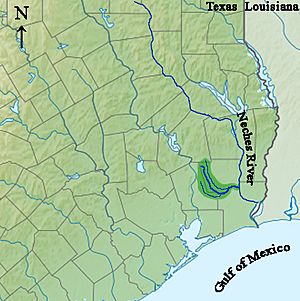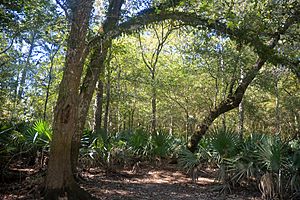Pine Island Bayou facts for kids
Quick facts for kids Pine Island Bayou |
|
|---|---|
| Country | United States |
| Physical characteristics | |
| Main source | circa Liberty/Hardin County line, Texas (ca. 30.4135°N, 94.6781°W) ca. 35 m. |
| River mouth | East end of Hardin/Jefferson county line, Texas (30.1625°N, 94.1155°W) 1 m. |
| Length | ca. 55 miles |
Pine Island Bayou is a cool river in southeast Texas. It's a branch of the Neches River. This bayou flows for about 55 miles. It starts near the border of Liberty and Hardin County. Then it winds its way southeast.
The bayou flows through western Hardin County. It then turns east. For about 20 miles, it forms the border between southern Hardin and Jefferson County. Finally, it joins the Neches River. Two important smaller rivers that flow into Pine Island Bayou are Mayhaw Creek and Little Pine Island Bayou.
The last ten miles of Pine Island Bayou are special. Much of Little Pine Island Bayou is also special. These parts are protected inside the Big Thicket National Preserve. This means they are kept safe from new buildings. The area around the bayou is not very crowded. Some small towns nearby include Sour Lake and Saratoga. Saratoga is famous as the birthplace of country singer George Jones.
Contents
The Heart of the Big Thicket
The land around Pine Island Bayou is very important. It is the true center of the Big Thicket. People sometimes call this area "The Traditional Thicket." They also call it "The Old Bear Hunters' Thicket." This region has many different kinds of plants and animals.
The land here is mostly flat and low. It has many floodplains and bottomlands. These are areas that can get flooded. The water in the bayou is often slow-moving and dark. This is why it's called a blackwater river.
Unique Habitats
The Pine Island Bayou area has several unique habitats. These include swamps and cypress sloughs. Cypress sloughs are wet areas with cypress trees. There are also hardwood bottomlands. These are forests with hardwood trees in low, wet areas.
You can also find palmetto-oak flats. These are flat areas with dwarf palmetto plants and oak trees. Another habitat is called baygalls. These are wet, swampy areas with specific types of trees.
Plants of the Bayou
Many interesting plants grow here. You can see water tupelo trees (Nyssa aquatica). There are also bald cypress trees (Taxodium distichum). These trees often have Spanish moss (Tillandsia usneoides) hanging from their branches.
Vines like rattan-vine (Berchemia scandens) and muscadine vine (Vitis rotundifolia) climb through the forests. These forests have trees like black gum (Nyssa sylvatica) and water hickory (Carya aquatica). Sweet gum trees (Liquidambar styraciflua) are also common.
Several types of oak trees grow here too. These include overcup oak (Quercus lyrata), laurel oak (Quercus laurifolia), willow oak (Quercus phellos), and water oak (Quercus nigra). In some places, dwarf palmetto (Sabal minor) plants cover the ground.
Animals of the Bayou
The Pine Island Bayou basin is home to many animals. Black bears (Ursus americanus) used to live here. But they disappeared from the area in the early 1900s.
Today, you can find many other animals. These include northern river otters (Lontra canadensis). There are also bobcats (Lynx rufus) and American beavers (Castor canadensis).
Reptiles are also common. You might see American alligators (Alligator mississippiensis). There are also alligator snapping turtles (Macrochelys temminckii). Cottonmouth snakes (Agkistrodon piscivorus) live here, along with several types of non-venomous watersnakes (Nerodia).
Fish Species and Life Cycle
Pine Island Bayou is full of fish. Records show that 56 different kinds of fish live here. Some of the fish you might find include alligator gar (Atractosteus spatula). There are also bowfin (Amia calva) and largemouth bass (Micropterus salmoides).
Other common fish are channel catfish (Ictalurus punctatus) and yellow bullhead (Ictalurus natalis). You can also find warmouth (Lepomis gulosus) and bluegill sunfish (Lepomis macrochirus). These fish play an important role in the bayou's ecosystem. They are part of the food chain for many other animals.



